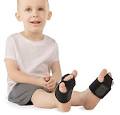Toe walking, also known as tiptoe walking, refers to a gait pattern where an individual mainly walks on their toes or the balls of their feet, with little or no contact between the heels and the ground. This behavior is often observed in young children as they are learning to walk and typically resolves on its own as the child grows stronger and more coordinated. However, for those who toe walk beyond a certain age or into later childhood, it can sometimes be a sign of an underlying condition, such as idiopathic toe walking, muscle or neurological conditions, autism spectrum disorders, or structural abnormalities.
When to Worry About Toe Walking?
It's important to consult with a healthcare professional if toe walking persists in children, as it may be indicative of an underlying condition that requires management. Persistent toe walking can sometimes be a sign of a more serious problem, such as cerebral palsy, muscular dystrophy, or Charcot-Marie-Tooth disease. Additionally, if toe walking is associated with other concerns such as muscle weakness, clumsiness, pain, or difficulty with balance, it is likely that the condition will require further evaluation.
Addressing Toe Walking: Treatment Options
Treatment for toe walking depends on the underlying cause and the severity of the condition. Here are some commonly used interventions:
-
Observation and reassurance: In some cases, toe walking may resolve on its own without intervention, especially in young children who are still developing their coordination and balance.
-
Physical therapy: A physical therapist can provide exercises and stretches to improve muscle strength, flexibility, and range of motion. They may also use techniques to promote a more typical heel-to-toe walking pattern.
-
Orthotic devices: Custom-made or prefabricated braces that provide stability and promote a more normal gait pattern.
-
Stretching exercises: For example, deep flexor and plantar flexor stretches can be effective in alleviating tightness that contributes to toe walking.
-
Serial casting: In cases of severe and rigid toe walking, this can involve applying a series of casts to gradually stretch the calf muscles and Achilles tendon over time.
-
Botox injections: When tight calf muscles are the primary cause of toe walking, Botox injections may be considered. These injections can temporarily weaken specific muscles, allowing for an improved range of motion and a more typical gait pattern.
-
Surgery: In rare cases where conservative measures have been ineffective, surgical intervention may be considered. The goal is to lengthen the Achilles tendon or address any structural abnormalities that contribute to toe walking.
Selecting the Right Shoes for Kids
When choosing shoes for a child who toe walks, several features can be beneficial:
-
Firm heel counters: These provide stability and help prevent excessive ankle movement, encouraging a heel-to-toe gait.
-
Arch support: Adequate arch support can help maintain proper foot alignment and promote a more natural walking pattern.
-
Flexible soles: Shocks and motions are absorbed well by shoes with a flexible sole, which allows the child to develop a more normal walking pattern and engage the muscles of the foot and ankle appropriately.
-
Proper fit: Ensure that the shoes fit well and are neither too loose nor too tight.鞋子过紧会限制脚部活动,导致不适;鞋子过松则可能不稳定。
Additionally, European-made shoes that provide optimal support, such as boots for kids with weak ankles, can be particularly helpful. These shoes are designed to train the heel to stay down and eventually end toe walking over time.
When to worry about toe walking in children
It's important to consult with a healthcare professional if toe walking persists and is associated with concerns such as:
-
The child walks on toes most of the time, causing a stiff and clunky gait.
-
The child has stiff muscles and walks uncoordinatedly.
-
The child stumbles often and walks unevenly.
-
The child has delayed or abnormal development of fine motor skills, such as difficulty tying shoes.
-
The child avoids eye contact and exhibits repetitive behaviors such as rocking or spinning.
##Toe walking is a common gait pattern in children, but it can sometimes be a sign of an underlying condition. consulting with a healthcare professional, such as a pediatrician, physical therapist, or a professional athlete who specializes in sports medicine and podiatry, is crucial to determine the underlying cause of toe walking. A proper diagnosis and treatment plan can help prevent or minimize potential complications and improve overall function and comfort for the child.







